
- Homepage
- Brand
- Artisan (17)
- Benchmade (51)
- Bestech Knives (57)
- Boker (37)
- Boker Plus (19)
- Case (28)
- Case Xx (55)
- Damascus (39)
- Fox (35)
- Kansept Knives (65)
- Kizer (25)
- Lionsteel (22)
- Qsp Knife (18)
- Sj Shi Jian (134)
- Sog (25)
- Spyderco (149)
- Swords' World (41)
- Viper (29)
- We Knife Co Ltd (19)
- Zero Tolerance (55)
- Other (1445)
- Capacity
- Model
- Power Source
- Type
- Warranty
Damascus Folded Steel Rosewood Chinese Sword Round Head Sui Dao Funtional Sharp
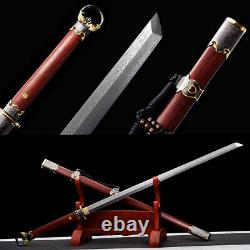
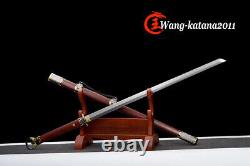


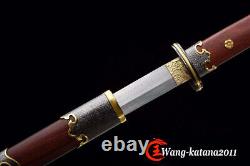
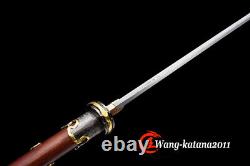
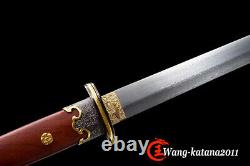
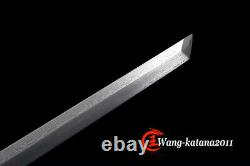
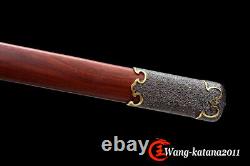
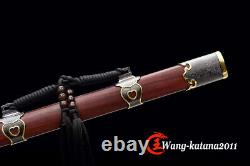
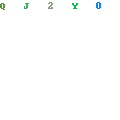
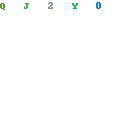
Damascus Folded Steel Rosewood Chinese Sword Round Head Sui Dao Funtional Sharp. Handle: 32 cm/ 12.6 inch.
Blade: 71 cm/ 27.9 inch. Overall: 110 cm/ 43.3 inch. Width: 3.2 cm/ 1.26 inch.Thickness: 0.7 cm/ 0.27 inch. Saya: Rosewood (Comfortable use, Beautiful natural wood grain).
Fittings: Alloy eletroplated gold, round head fittings. It's a functional sword, You can use it cut through iron wires, Water bottles, tatami, etc. Blade Craft: Hand folded forged by 11 times(2048 layers), water quenching treatment, hand-polishing, etc.
Natural riffle texture, caused by folding process. The sword stand is not include. Modern vacuum heat treatment can meet the hardness requirements of most swords, but the traditional quenching method has better effect, can soften the medium strip steel, and the hardness is higher. Dao are single-edged Chinese swords, primarily used for slashing and chopping. The most common form is also known as the Chinese sabre, although those with wider blades are sometimes referred to as Chinese broadswords. Swords have a long history in China. Bronze swords have been traced back to the bronze daggers of the Shang dynasty. Bronze long swords suddenly appeared during the mid-third century BC. Later swords were made of iron or steel.These metals were wrought, never cast. Swords commonly reached a length of 70-100 cm, although longer swords have been found. Chinese iron swords were used in Japan from the third to sixth century AD, but were replaced with Korean and native Japanese swords by the middle of the Heian era. The Chinese classify all swords into two types, jian and dao.
Jians are dual-edged while daos are single-edged. This means that the carbon steel is folded by 11 times to produce 2048 layers. The higher quantity of layers provides more unique and mystical hada patterns, which defines and displays the craftsman's experience and knowledge of traditional metallurgy passed down from generation to generation. Only the utmost skilled bladesmiths (Toushyo) and polishers (Togi-shi) can bring out the beauty and life from the Shinsakuto live blade. During the forging process, all of the slags and impurities of the steel are burned off and folded forged to an uncompromised strength with an sharp cutting edge.
The final carbon content is 1% and the hardness is an impressive HRC 55 on the Rockwell Scale. This high quality blade can easily cut through tatami straw mats or bamboo for Tameshigiri or Batto-do use. It's free for engraving English words, Chinese Characters and Japanese Kanji, etc. Most of our blades are sharp. We can also make the blade unsharpened for free if you require.
The price varies from different swords. We have our own sword-casting factory. The factory is located in Longquan, a small town with a long history of sword-casting in China.Most of the famous Swords in China are made there. Rich raw materials, skilled technology, traditional sword casting technology from generation to generation.
Manual production really takes a lot of time. We hope to get your understanding. Each handmade sword is unique. Our swords are great for gifts or for your own collection.
Our swordsmithing master makes every sword attentively, hope you can feel our sincerity. After the blade has been shaped, the sword would be quenched. We quench our swords in either water or oil. Water quenching produces a tougher edge which can also be hardened further more using clay. Blades quenched in oil are still considerably hardened and do have superior flexibility compared to a water quenched blade.In the forging process, the most useful process is the folding, where the metals are forge welded, folded, and welded again, as many as 124 times(15 times is the best). The folding removes impurities and helps even out the carbon content, while the alternating layers combine hardness with ductility to greatly enhance the toughness.
The less impurities, the harder and sharper the blade will be. We have done cutting tests on the blades. It can cut bamboo(young bamboo tree), grass mattings and slice paper(The blade should be tilted at 45 degrees). To maximize both the cutting edge and the resilience of the sword spine, a technique of differential heat-treatment is used.
The sword is painted with layers of clay before heating, providing a thin layer or none at all on the edge of the sword, ensuring quick cooling to maximize the hardening for the edge. A thicker layer of clay is applied to the rest of the blade, causing slower cooling. This creates softer, more resilient steel, allowing the blade to absorb shock without breaking. The best quality of high carbon steel is at 1095, the carbon content was 1.03%, and the element contains a small amount of chromium, molybdenum, vanadium, after heat treatment can reach HRc58-60 hardness, toughness is very good, but not resistant to rust, more be applied to traditional european-style hunting knife, large cutting knife and military dao. Such as the United States during world war ii "KA - BAR" saber is in 1095 as the blade material.
The vast majority of modern katana and wakizashi are the maru type which is the most basic, with the entire sword being composed of a single steel. The kobuse type is made using two steels, which are called hagane (edge steel) and shingane (core steel). Steel of different materials is forged and welded together to hammer the basic shape of the sword. This allows the overall blade to have a higher toughness and absorb a lot of impact.Reducing the possibility of breaking or bending to some extent. Makes the blade not only has high hardness, but also has super toughness. B If you do not receive the package, or the package is damaged during transportation. We'll take care of it. If it is mentioned in the product description that the package includes the sword bag or sword holder, the style will be random.
D If you have any problem after recieve the package wrong size, wrong style, etc. We always provide you with the best after-sales service. Please give us a chance to help you before you give us a bad feedback.
